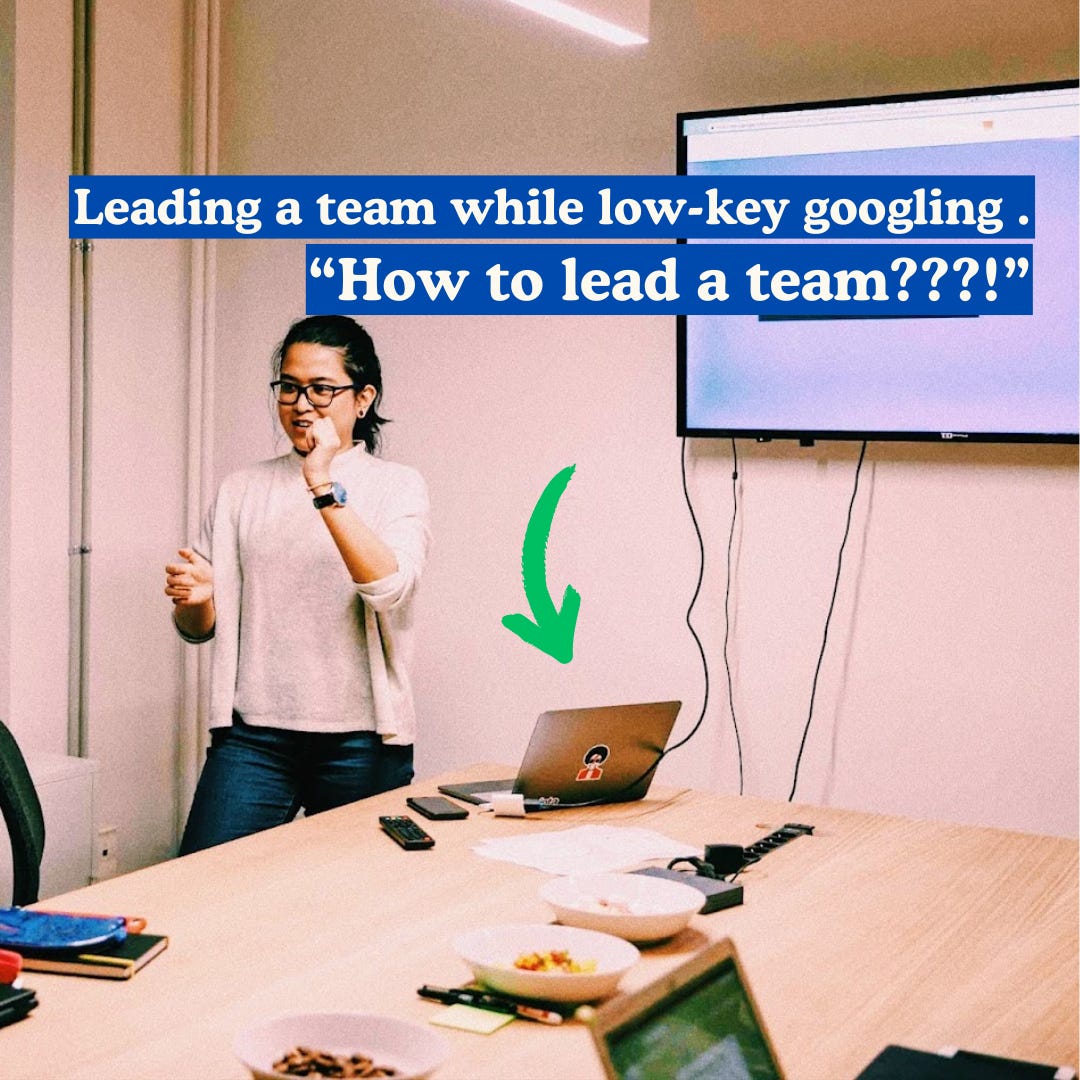#66 The New Product Leader Dilemma (Part 3): You Got the Title. But Where’s the Manual?
The invisible load new leaders carry (and how to stop feeling like you're failing at all of it)
Welcome back 👋 and we’re at Part 3 of this 3-part series on the top 3 challenges that new Product Leaders face and what makes the transition from Individual Contributors feel like Sisyphus rolling a rock up a hill:
They struggle to make the shift from being the executor to enabler
They struggle with the mental load of being a leader - this issue ✍️
It’s not as sexy as we think it is
A lot of Senior PMs want to move up to a leadership role.
Maybe because it feels like the natural step — the only one.
Maybe because it looks like the place where real influence happens.
Maybe because the role just looks like success. Sexy title. Endless opportunities.
But when we finally get there? It’s a lot messier than we expected.
Not because we’re doing anything wrong; but because what the job actually requires is nothing like what we were doing before.
Not because we’re just bad at leadership, but because leadership asks us to show up in ways we were never trained for. (but also real talk, nobody’s good at this from the beginning, though!)
In Part 1 we talked about shedding the identity of the executor and stepping into the role of an enabler. Someone who empowers their team to deliver value, instead of trying to do it all themselves.
Then in Part 2, we explored politics. Not the shady stuff, but the real work of building influence, alignment, and trust in a system that doesn’t always make that easy.
And now, we arrive at Part 3: What happens when we’re doing all the “right” things and it still feels like we’re drowning?
This is about the mental and emotional overload of leadership.
Because if you’ve ever thought:
“I don’t know what I’m doing and I can’t ask anyone.”
“Everyone needs something from me, and I haven’t peed in six hours.”
“I’m trying so hard, but people still aren’t happy.”
You’re not broken. You’re carrying the load most people don’t talk about.
And you might be doing it without training, support, or space to breathe.
Let’s talk about what that weight really is and how to finally set some of it down.
Why this feels so hard
Let’s be honest: most new Product Leaders don’t get real training on how to lead.
Especially if we’re promoted from within. One day, we’re the safe space for venting about leadership. The next, we are leadership.
And that shift? It’s jarring. For us, and for the people around us.
We’re no longer “one of them,” but we’re not fully trusted as “the leader” either. Not yet.
So we tiptoe. We overexplain. We second-guess. We don’t want to overstep. But we also don’t want to let anyone down.
That in-between space? That’s where mental and emotional overload lives.
So we carry:
The pressure to have the answers, even when we’re still figuring it out
The responsibility to hold space for everyone else’s emotions, even when we’re unsure of our own
The unspoken expectation to speak the right language with leadership, while shielding our team from chaos below
And we often feel like we have to do it all alone.
Our new peers don’t quite feel like peers yet.
Our old peers now look to us for direction.
We’re managing up, trying to prove we deserve the role.
So we start second-guessing everything. And we hear vague feedback like:
“Be more strategic.”
“Drive alignment.”
“Coach your team better.”
Cool. But what does that actually mean?
Do we need to be louder? Bring more frameworks? Pretend to have it all figured out?
Sometimes the pressure gets so loud we start to believe:
“Maybe I’m just not cut out for this.” or “Maybe I should have just stayed an IC.”
One of my coaching clients, a new Product Director told me she’d leave every leadership meeting feeling like she didn’t belong.
She thought her peers were faster. More articulate. Infinite well of ideas. And she can’t keep up, or so she thought.
But she wasn’t “behind.” She was just wired differently. And in leadership, different can be a strength. But only if we stop treating it like a flaw.
Honestly, even seasoned leaders still wrestle with this. They’re just better at hiding it. Or they’ve built more tools to catch the spiral before it takes over. 😅
When we don’t pause to question these beliefs, we internalize them.
They shape what we say yes to. What we carry. And then we twist ourselves into knots trying to meet expectations that were never actually spelled out.
I’ve been there.
And then we’re like… why does this still suck? Even when nothing’s on fire?
Leadership isn’t just a role shift. It’s a reality shift. ✋🎤
⛑️ If you're a new product leader going through your dilemmas, I'd love to support you. Click here to book a discovery call with me and let's chat about the support you need and how we can collaborate together. 🤙Strategies for Change
So how do we stay centered and fulfilled in the face of all this?
Here are four strategies I’ve leaned on (and helped others lean into) that make the emotional load of leadership feel a little less heavy, and a lot more doable.
disclaimer: Not every environment makes this kind of leadership feel possible especially when the culture values output over people, or speed over care. But if we’re going to stay in these roles and make a real difference, we have to find ways to lead that still feel true to us.1️⃣ Define your values and align your leadership to them
When we’re navigating expectations from all sides, our values become our anchor.
If transparency is one of our values, maybe that looks like looping our team in even when we don’t have all the answers… and trusting them with the nuance.
If collaboration is a value, maybe it means making space for input, even when a top-down decision would be faster.
If fun is a value (yes, it counts), maybe we add some humor into our meetings, even during crunch time; because our teams perform best when morale is high.
Our values become our internal compass when everything else feels uncertain.
They help us make better calls, faster. And they give us a sense of what “good” actually means — not some LinkedIn version of leadership, but the one that makes sense to us.
And here’s the part we forget: We are not just our titles.
Even if it feels like our self-worth is riding on every decision we make.
The more we detach our identity from the title, the easier it is to lead with integrity not fear.
Because when our sense of self is rooted in our values, not our job, we make decisions that reflect what actually matters. Not just what quiets the noise or wins approval.
Even when the work is messy, we stay steady; because we’re anchored in something we chose.
2️⃣ Define your leadership presence
This isn’t about looking polished or performing leadership. It’s about the energy we bring into the room.
People aren’t just responding to our strategy or ideas. They’re responding to us and how we make them feel.
And that response is shaped by how we carry ourselves, how we communicate, how we hold space in a room (or a Zoom), and how we manage pressure.
Because presence isn’t just tone or posture or eye contact. It’s steadiness and how it builds trust. It’s being someone people want to follow.
Not because we’re the loudest, but because we help people feel seen, safe, and supported.
It’s also about restraint. When everything feels urgent and emotionally loaded, our job isn’t to react. Our job is to respond. And sometimes, not at all.
That means learning when to speak, when to pause, and when to let go.
Because if we respond to every fire with fire, we’re going to burn ourselves out soon enough.
3️⃣ Give yourself the support you need
We’re not supposed to have it all figured out.
And yet, so many of us feel like asking for help means we’re failing. That we should already know how to hold hard conversations, coach effectively, align with leadership, manage team dynamics, and juggle all the processes around budgets, performance, and promotions too. Wow. The pressure!
Unfortunately, it doesn’t work that way.
And no one taught us how to lead, then we get to build our own curriculum.
We can work with a coach. Find a community. Ask our manager what support exists.
And if nothing is offered, we start with our peers. Some of the most useful insights come from honest conversations with other leaders figuring it out, too.
Just because no one gave us onboarding document doesn’t mean we have to figure it out alone. Doesn’t matter where the support comes from, but sometimes we need people who can hold space for us. People we can be honest with, vent to, and get perspective from.
No shame confession: I used to have group calls with my peers who are also first time product leaders blocked out in my calendar just to vent, ask for advice, or gain perspective. It was like group therapy. And the relief after every call was real. Asking for help isn’t a weakness thing. It’s an “I actually give a damn about doing this well” thing
The strongest leaders aren’t the ones who go it alone. They’re the ones who know when to ask for help and aren’t afraid to do it.
4️⃣ Lead with a vision for your product, your team, and yourself
Without a clear direction, it’s easy to get swept up in every escalation, preference, or request that comes our way.
We don’t need a five-year plan. But we do need a sense of what “good” looks like. A north star. Not just for our product strategy but for our team culture and leadership, too.
Some guide questions:
What kind of team are we building?
What kind of environment are we nurturing?
How do we want people to feel when they work with us?
What kind of leader are we working toward becoming?When we know the answers to those, it becomes much easier to decide what to prioritize, what to let go of, and what to simply not respond to without spiraling into self-doubt.
Not everything’s ours to fix. And not everything going sideways means we’ve failed as a human.
But our vision? That’s ours to hold. And that’s where we lead from.
TL;DR: Leadership is being human.
No one tells us that stepping into a Product Leadership role means walking straight into a storm of expectations… many of them unspoken, conflicting, and some that can feel impossible to meet.
We’re not just managing roadmaps. We’re managing people’s emotions, team dynamics, career growth, stakeholder tension, and our own self-doubt. Often without much support.
That’s a lot. And yet… it’s the job
It’s no wonder we start to question ourselves.
But maybe we’re not doing it wrong. Maybe we just need to lead from a different place.
And here are four ways we can start anchoring ourselves:
Define our values. Make decisions we’re proud of and lead in a way that reflects who we are — not just how stressed we are
Own our leadership presence. We don’t need to be the loudest voice. But we do need to be a steady one. Leadership becomes more sustainable when we’re intentional, not performative.
Give ourselves the support we need. Ask for help. Share the load. Leadership isn’t a solo mission.
Lead with a vision Not just for our product, but for the kind of team we want to build, and the kind of leader we want to become. It keeps us grounded when everything else feels chaotic.
Leadership isn’t about doing more, being more, proving more. It’s about leading in a way that doesn’t make us want to run away from Slack forever.
Turns out, the key to not burning out isn’t working harder. It’s leading on our own damn terms.
📌 Coaching Bulletin Board:
📌 1:1 Coaching for the new Product, UX, and Tech Leaders going through your dilemmas. I’d love to help you define your strategies to set yourself and your team up for success. Book a free call and let’s discuss how we can work together.
📌 Feeling stuck in your career but not sure what to do next? Join my free 90-minute workshop on April 24 to explore new possibilities and create your own opportunities
📌 Magical Audios is giving away a free guided self-hypnosis for healing burnout. Click here to start listening.









I wish more of the leaders I've worked around over time would have incorporated the ideas you mentioned. Doing more to make the work environment feel like a team (not family...eye rolls) and giving people a sense that you care about the team can go a long way.